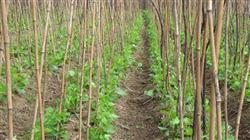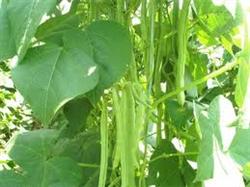Technical points of interplanting kidney beans in cotton field

The interplanting mode of kidney bean and cotton is a characteristic planting pattern in Mancheng county. The planting mode has 1750 kilograms of kidney beans per mu, an output value of 1300 yuan, a seed cotton yield of 200kg, an output value of 960 yuan, a total output value of 2260 yuan, deducting costs of 430 yuan, and a benefit of 1830 yuan per mu. The main points of cultivation techniques are as follows: first, kidney bean varieties with a growth period of 50-55 days were selected, and improved varieties of insect-resistant cotton were selected for cotton. Second, prepare before the broadcast. Pour enough water on the bottom of the soil. If the soil moisture is not good, make soil moisture from late February to early March. two。 Fertilize. Apply organic fertilizer (mainly chicken and ring manure) 2-3 cubic meters, ammonium bicarbonate 25 kg or urea 10-15 kg per mu, sprinkle on the ground and carry out shallow and middle ploughing. 3. Fine soil preparation and border formation. The width of the border is generally 2 to 2.2 meters or 4 to 4.4 meters. Third, sow seeds ahead of time. Sowing time. Kidney beans were sown in the first and middle of March, while cotton was sown in mid-and late April. two。 Sowing form and density. The ultra-thin plastic film of 1.8 μ m was selected to cover. Kidney bean was sown with large and small rows of open ditches, 3 seeds per hole, depth of 2 cm, 6 rows of plastic film, 40 cm of large row, 17 cm of small row, 33 cm of average row spacing, 17 cm of hole spacing, 7500 ~ 11000 holes per mu and 12.5 ~ 15 kg per mu. Planting cotton with a shovel knife, planting 3 grains per hole, sowing depth 2 cm, sowing rate 0.6 kg per mu, covering soil in the shape of steamed bread after sowing, easy to water or break the plate after rain, row spacing 66 cm 90 cm, plant spacing 30 cm 35 cm, the number of plants per mu 2400 to 2900. 4. Cultivation and management of kidney beans in ㈠ 1. Break the membrane and release the seedlings. Kidney bean began to emerge in late March and completed the emergence process after 10-15 days. It is necessary to check the emergence every 2-3 days, generally wait for cotyledons to flatten, break the membrane and release seedlings as early as possible to prevent high-temperature seedling burning. two。 Seal the soil, moisturize and raise the temperature. After the kidney bean seedlings are complete, seal the seedling mouth with fine soil to avoid water evaporation and maintain soil moisture, which is beneficial to improve ground temperature, promote seedling growth and kill weeds at high temperature. 3. Sprinkle soil on the border to control weeds. For the land with serious weeds, pressing a layer of fine soil above the film can prevent the growth of weeds. 4. Prevent diseases and insects. Due to the early sowing of kidney bean, low temperature, high humidity, serious occurrence of seedling blight and root rot, Kangkuning and other agents should be used for spray and root irrigation control. The main pests are ground tiger, beetle, cotton bollworm and so on. Ground tiger, beetle and other underground pests were controlled by phoxim poisonous soil, poison bait or methotrexate spray, and cotton bollworm was sprayed with pyrethroid pesticides. 5. Water and fertilize. It is generally mastered that when the beans grow to 2-3 cm, the first water will be watered, and 10-15 kg urea will be applied to the plots that have not applied chemical fertilizer before sowing. ㈡ cotton management area kidney bean and cotton symbiosis time 4050 days, this period cotton is in the seedling stage, the kidney bean is in the flowering and pod stage, the contradiction between fertilizer and water demand and supply is prominent, according to this characteristic, we should focus on the following technical implementation: 1. Clear seedlings in the morning and ploughing in the middle. From the end of May to the beginning of June, the seedlings of kidney beans should be cleared immediately after picking, the cotton should be ploughed and loosened, and the temperature should be raised by breaking the plate. two。 Topdressing and watering. The first fertilization was in the middle and last ten days of June, combined with watering, the application of diammonium and urea per mu was 7.5 kg and 7.5 kg per mu, and the second fertilization was from late July to early August (flower and boll stage). 3. Prune. Due to the large spacing between cotton plants, good ventilation and light transmission, and sufficient stamina, the management is mainly to catch summer peaches and autumn peaches, especially early autumn peaches. ① topping: after beating before July 15-20, there were 10-12 fruit branches per plant. In ②, there were 2 fruit nodes in the lower 2-3 fruit branches, 3 fruit nodes in the middle fruit branches, and 4 fruit nodes in the other upper fruit branches. And remove the crazy branches and superfluous buds in time. 4. Chemical control. Before and after topping, spray control with 3 ~ 4 grams per mu. 5. Pest control. ① underground pest control method is the same as kidney bean. ② cotton bollworm: the second generation of cotton bollworm was sprayed twice. ③ red spider: the occurrence of kidney bean red spider is serious, and the residue is large. After cleaning the seedlings, Awei Chong Qing, Damien and so on were sprayed for 1 and 2 times. ④ cotton weevil and cotton thrips: phoxim and pyrethroid pesticides were used for control for 1 and 2 times. Cotton diseases are mainly caused by cotton stage blight, and the control methods are the same as above.
- Prev

High yield and High efficiency cultivation of Autumn Kidney Bean
Autumn kidney bean, also known as knife bean and kidney bean, is one of the main autumn vegetables in Dongtai City, Jiangsu Province. It has been popularized and planted in more than 20, 000 mu from 2004 to 2007, with a yield of 1300-1400 kg per mu and an output value of 1800-2200 yuan. In addition to the supply market, the products are mostly used for foreign trade dehydration processing. First, arrange the stubble reasonably. Plant Qiuyun.
- Next

Key points of efficient cultivation of cucumber interplanting kidney bean
At present, kidney bean cultivation in greenhouse is in the stage of vine flowering, how to ensure its high yield and harvest? it is suggested that vegetable farmers should grasp the following key measures for management. First, timely pinching kidney bean in greenhouse and open field kidney bean cultivation environmental conditions are different, due to the higher temperature in the greenhouse shows the growth rate.
Related
- The first cup of black tea in spring, the flavor and history of tea gardens in Kenya, Africa
- The computer can not only choose potatoes, but also grow tea rice. AI will grow winter oolong tea champion.
- It is not only the inflated tea bitten by insects, but also engraved with the four seasons tea in Beipu.
- The Oriental Beauty Tea Festival in Zhuxian County takes the stage at the weekend to experience the plus-size feast of oil tea.
- & quot; Oriental Beauty Tea & Exploration of Emei in Hsinchu, the hometown of quot;
- The new variety of strawberry "Tainong 1" dessert is the first choice with mellow aroma. Crimson gorgeous
- History of Tea in Taiwan: from Wild Inner Mountain to Export Tea Garden
- Two types of Taiwan Oriental Beauty Black Tea won the British three-Star Award for Childhood Tea Xiang Zhang Jiaqi changed from pilot to champion tea maker.
- Banana species and varieties: the planting history of Taiwan Xianren banana and dwarf banana is long, is banana disease resistant?
- Coffee planting Technology: Qianjie Coffee from Seedling to harvesting

